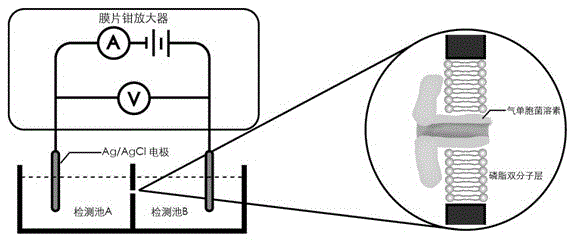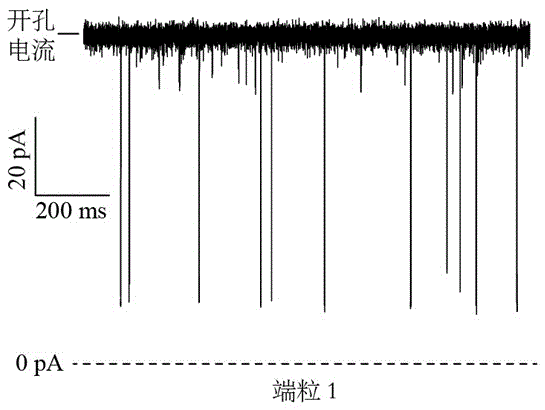Telomere length detecting method based on biological nano channel of aerolysin
An Aeromonas lysin and biological nano-channel technology, applied in the field of life science, can solve the problems of complex detection process, inability to directly measure telomere length, inability to detect the actual length of telomere, etc. The effect of low consumption and low price
- Summary
- Abstract
- Description
- Claims
- Application Information
AI Technical Summary
Problems solved by technology
Method used
Image
Examples
Embodiment 1
[0042] A method for detecting telomere length based on an aerolysin biological nanochannel, comprising the following steps:
[0043] (1) Open the G-quadruplex structure of telomeric DNA
[0044] The determined human telomere DNA is telomere 1——5'-TTAGGG-3'.
[0045]Telomere 1 was added to 1 mL of electrolyte solution, which was 1 M magnesium chloride (MgCl 2 ) and 10mM tris(hydroxymethyl)aminomethane buffer (Tris), pH=7.4, were mixed with a constant temperature magnetic stirrer at 25°C for 20min.
[0046] Since the formation of the G-quadruplex structure is cation-selective, different configurations will be formed in different kinds of alkali metal salt solutions: in the most commonly used potassium chloride (KCl) The formation of the conjoined structure can promote the formation, but this structure is not conducive to the precise detection of DNA by the nanochannel, and will also hinder the passage of DNA through the nanochannel.
[0047] Since the electrolyte solution use...
Embodiment 2
[0068] A method for detecting telomere length based on an aerolysin biological nanochannel, comprising the following steps:
[0069] (1) Open the G-quadruplex structure of telomeric DNA
[0070] Basic content is the same as embodiment 1. The difference is that the measured human telomere DNA is telomere 2——5’-(TTAGGG) 2 -3.
[0071] (2) Preparation of Aerolysin Bionanochannels
[0072] Basic content is the same as embodiment 1. The difference is: the electrolyte solution containing the telomere 2 is added to the detection cell A (cis end).
[0073] (3) Detection of telomere length by aerolysin bionanochannel
[0074] Basic content is the same as embodiment 1. The difference is: Example 2 is measured by the detection data analysis, the blocking time of telomere 2 is 3.0ms, and the blocking degree is 92% (see image 3 ).
Embodiment 3
[0076] A method for detecting telomere length based on an aerolysin biological nanochannel, comprising the following steps:
[0077] (1) Open the G-quadruplex structure of telomeric DNA
[0078] Basic content is the same as embodiment 1. The difference is that the measured human telomere DNA is telomere 3——5’-(TTAGGG) 3 -3.
[0079] (2) Preparation of Aerolysin Bionanochannels
[0080] Basic content is the same as embodiment 1. The difference is: the electrolyte solution containing the telomere 3 is added to the detection cell A (cis end).
[0081] (3) Detection of telomere length by aerolysin bionanochannel
[0082] Basic content is the same as embodiment 1. The difference is that in Example 3, the blocking time of telomere 3 is 6.0 ms and the blocking degree is 95% (see Figure 4 ).
PUM
 Login to View More
Login to View More Abstract
Description
Claims
Application Information
 Login to View More
Login to View More - R&D
- Intellectual Property
- Life Sciences
- Materials
- Tech Scout
- Unparalleled Data Quality
- Higher Quality Content
- 60% Fewer Hallucinations
Browse by: Latest US Patents, China's latest patents, Technical Efficacy Thesaurus, Application Domain, Technology Topic, Popular Technical Reports.
© 2025 PatSnap. All rights reserved.Legal|Privacy policy|Modern Slavery Act Transparency Statement|Sitemap|About US| Contact US: help@patsnap.com



